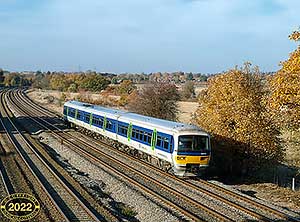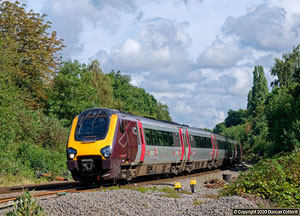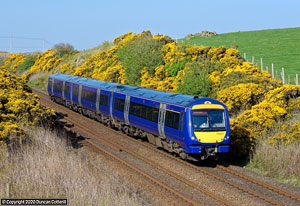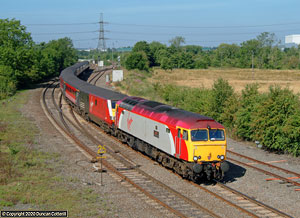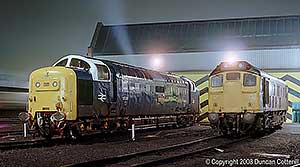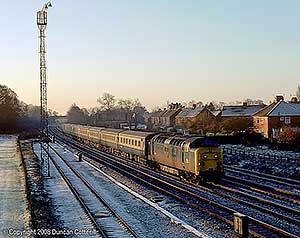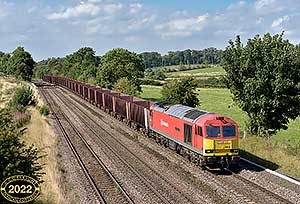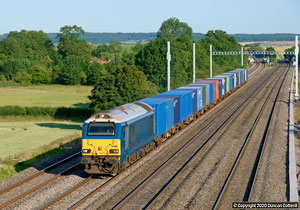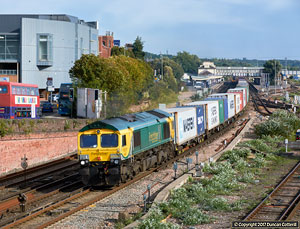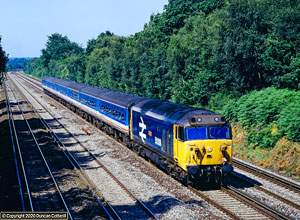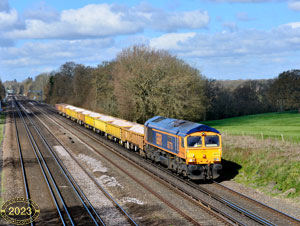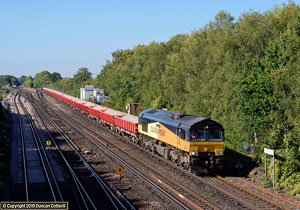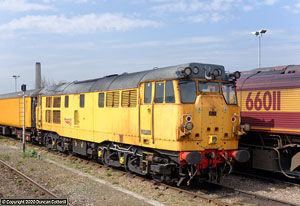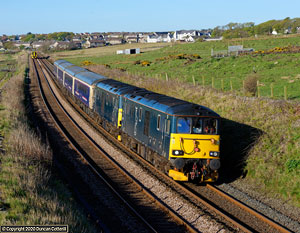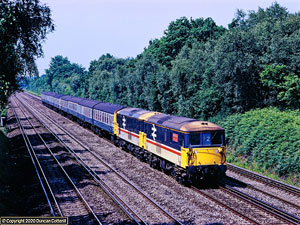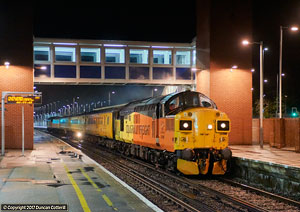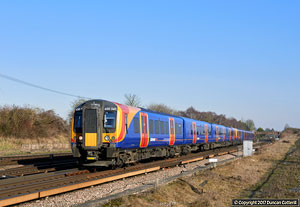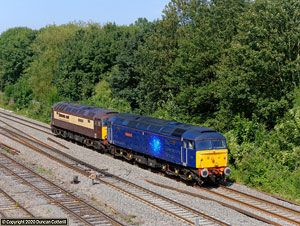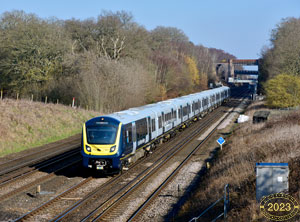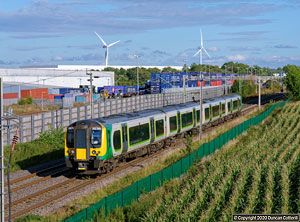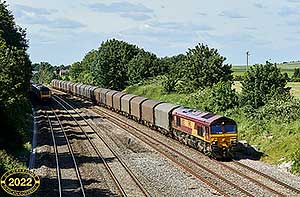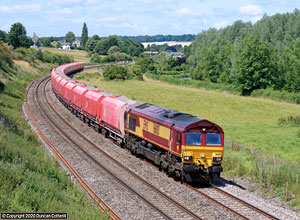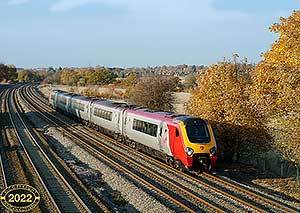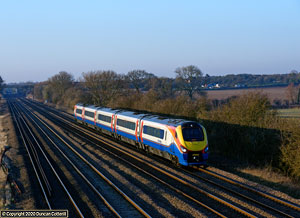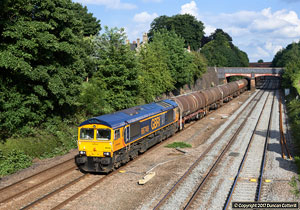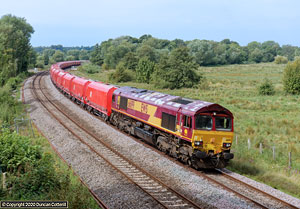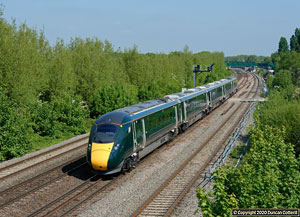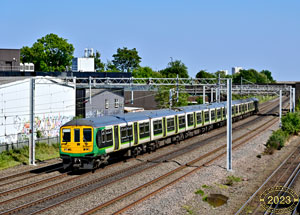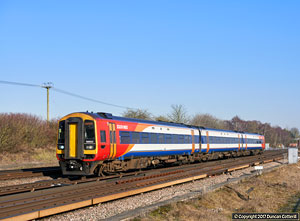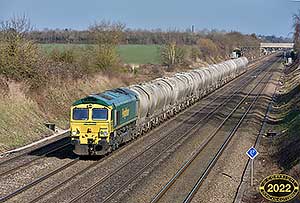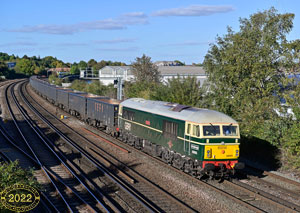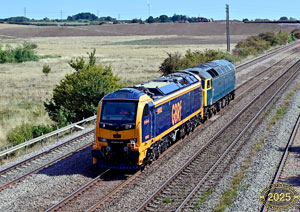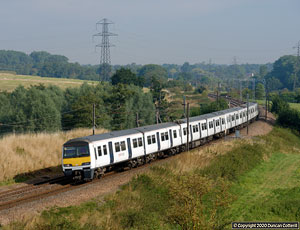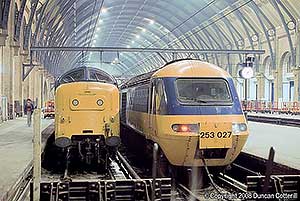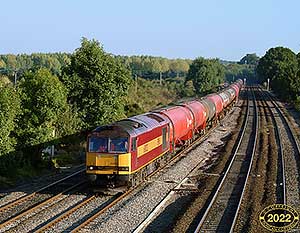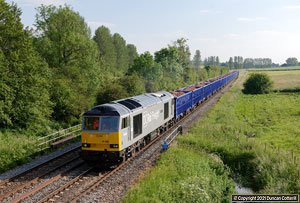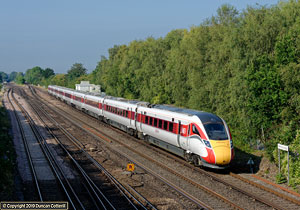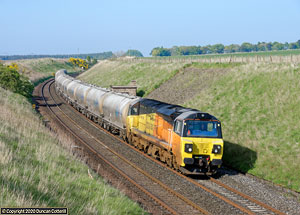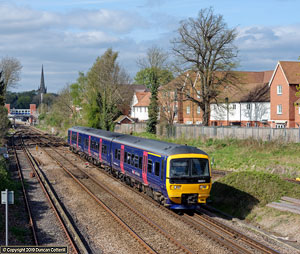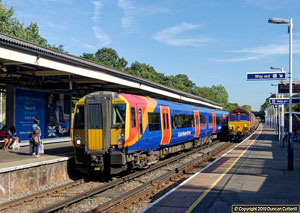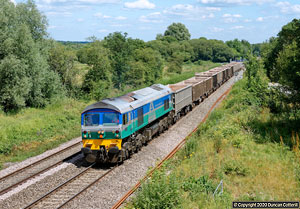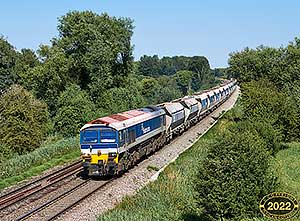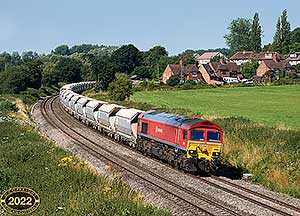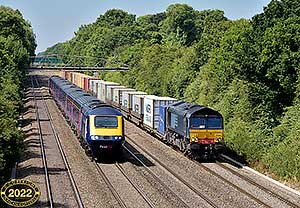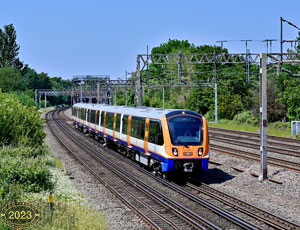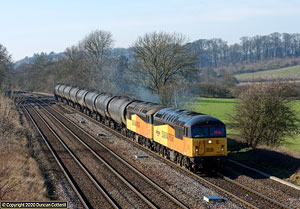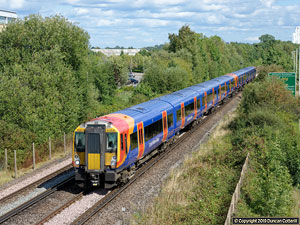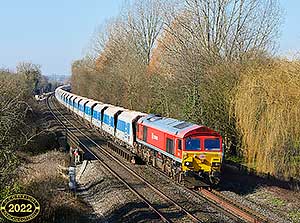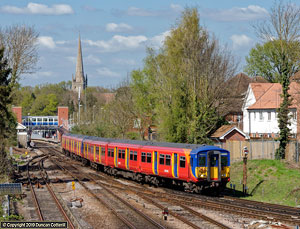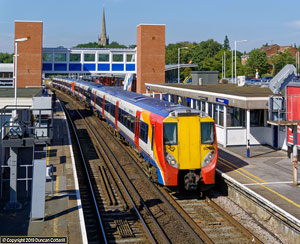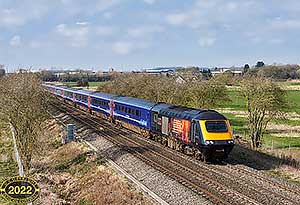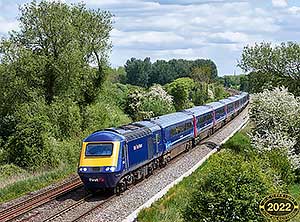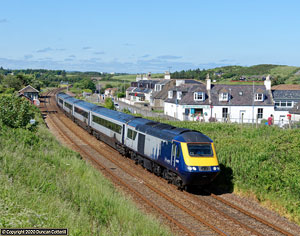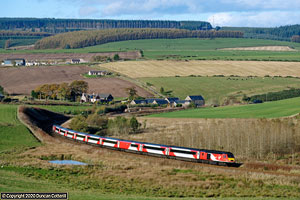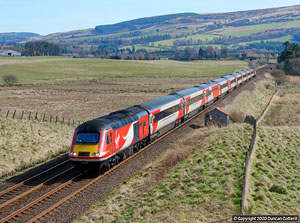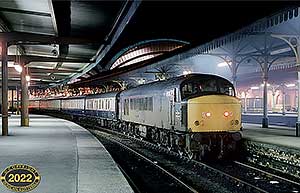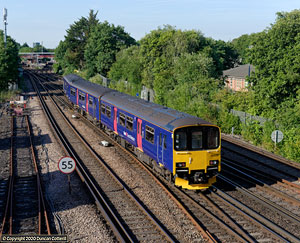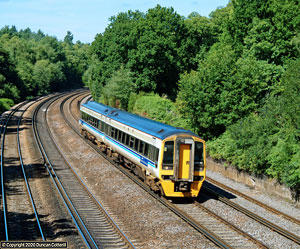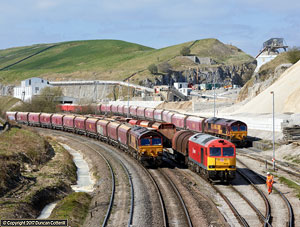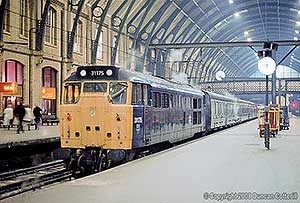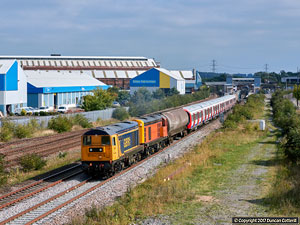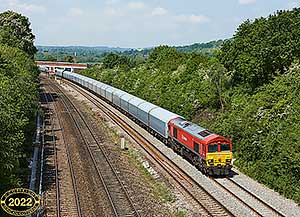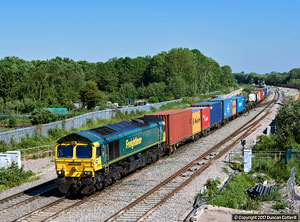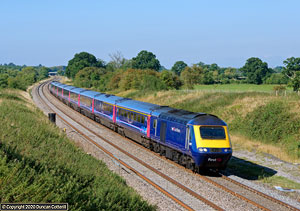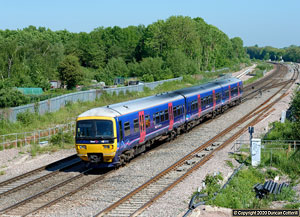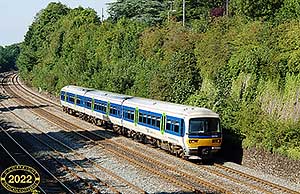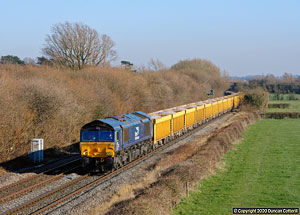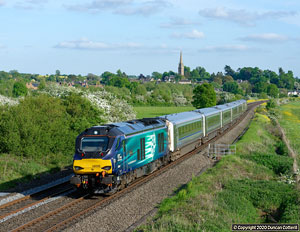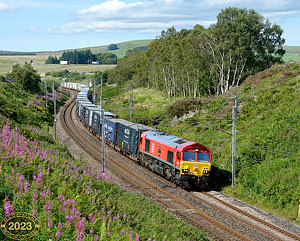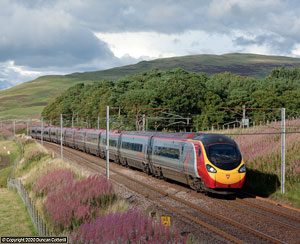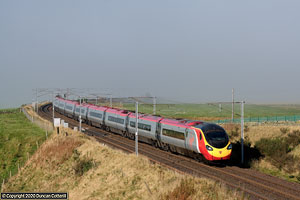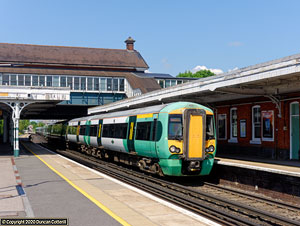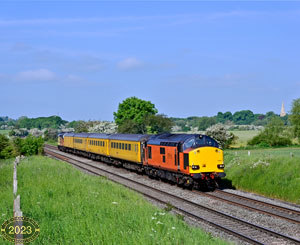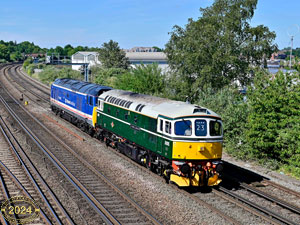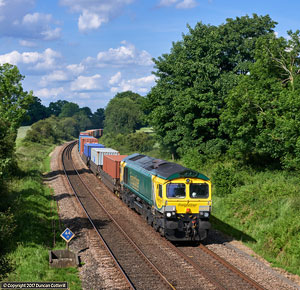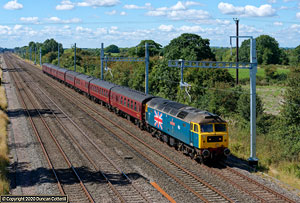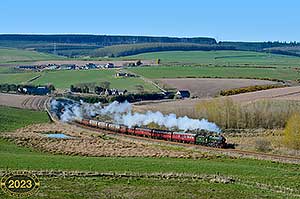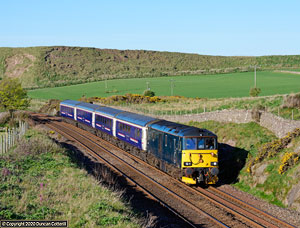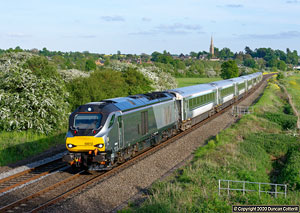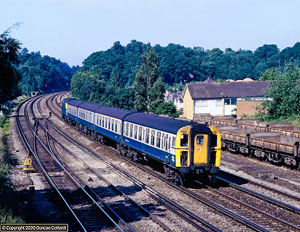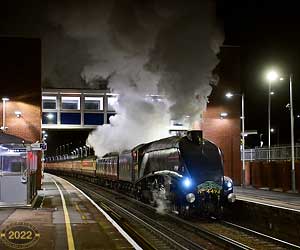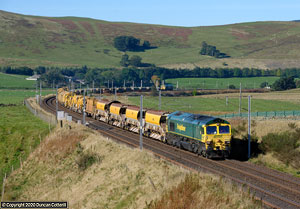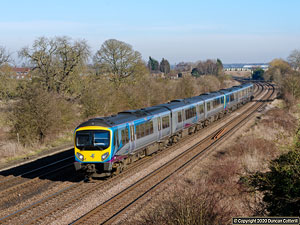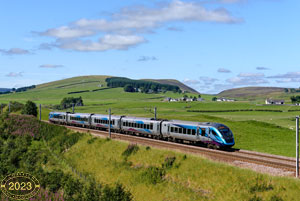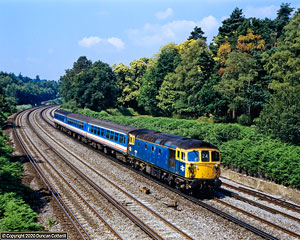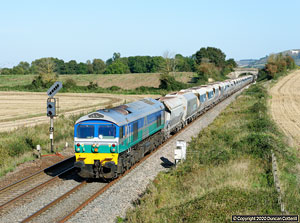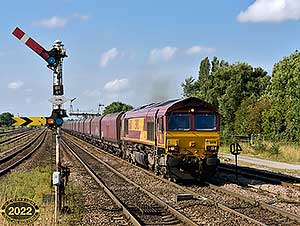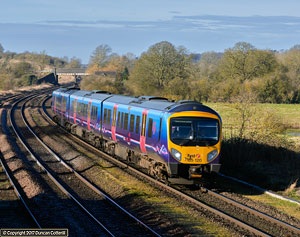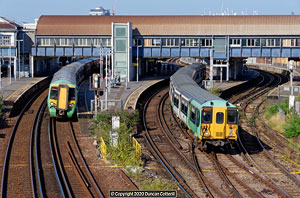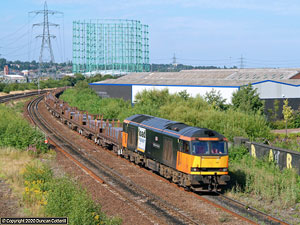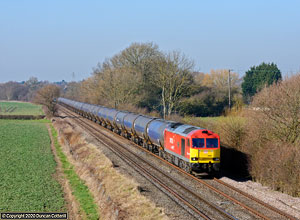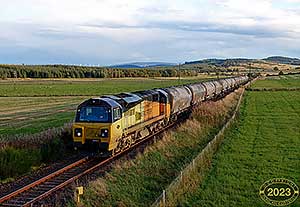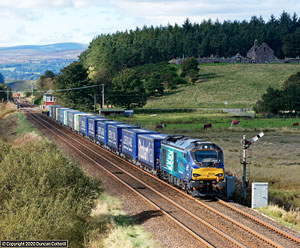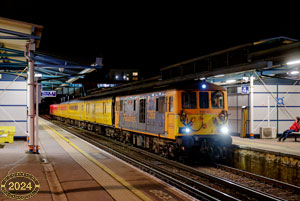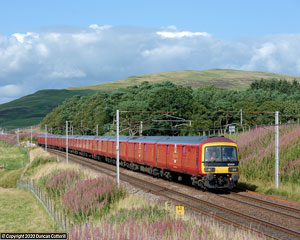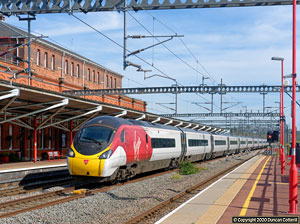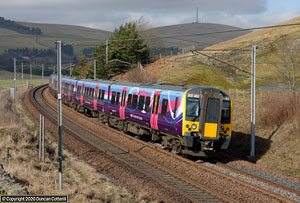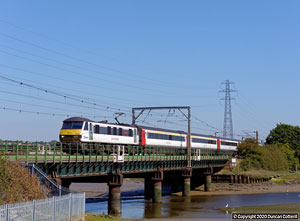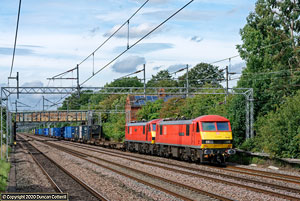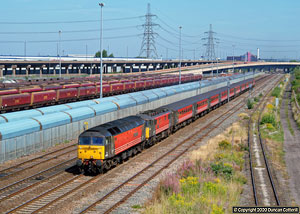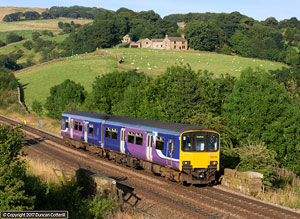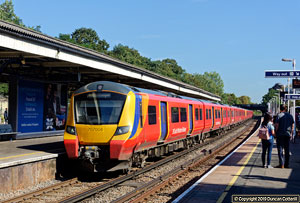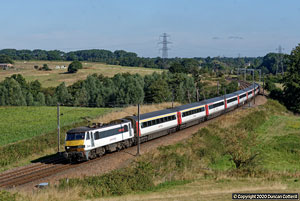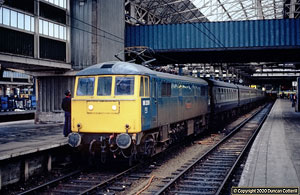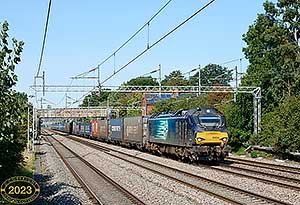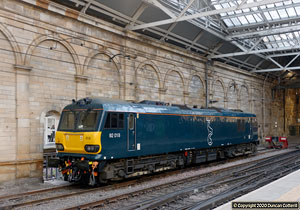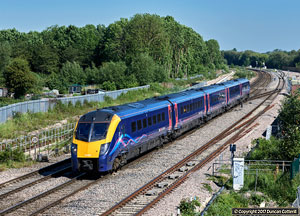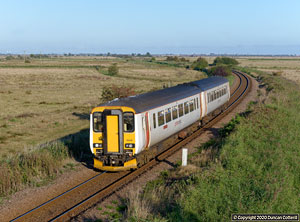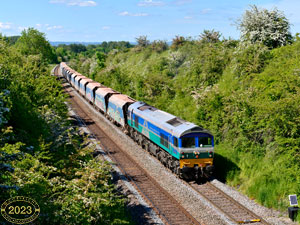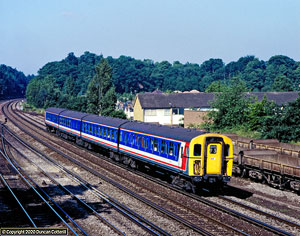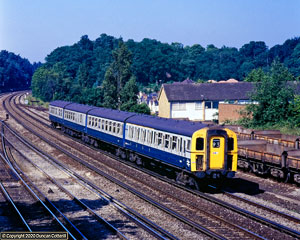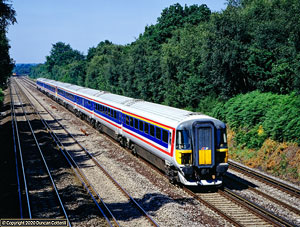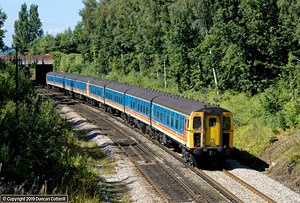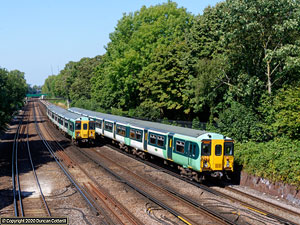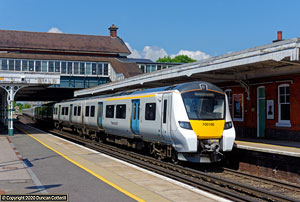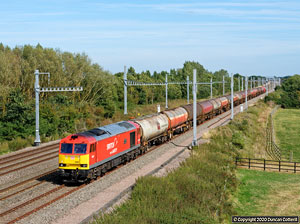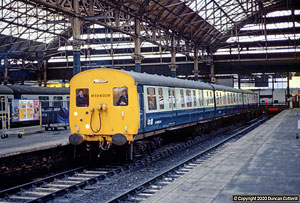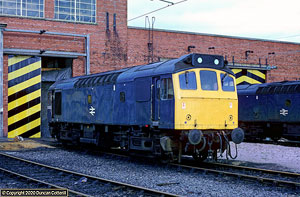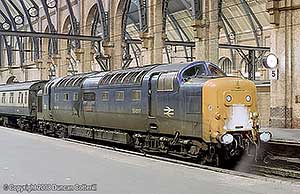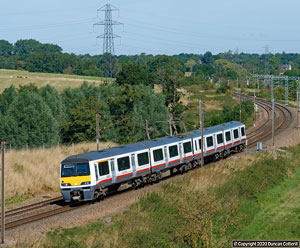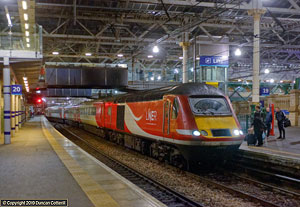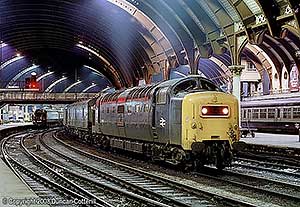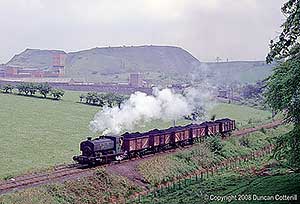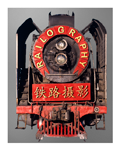DMUs
397 photos
updated : 2025-11-10
Diesel Multiple Units have been a significant part of the British railway landscape since the modernisation plan units first appeared in the late 1950s. Their use has since expanded from local and suburban services to almost all passenger trains on non-electrified lines, including long-distance expresses.
Cross Country
73 photos
updated : 2025-11-10
The Cross Country franchise operates a number of medium and long-distance services via Birmingham, none of which serve London. Most trains are worked by Class 220 or 221 DEMUs. A fleet of Class 170 DMUs covers secondary routes. The HSTs and loco hauled trains formerly used are now withdrawn.
Class 168 & 170-172
88 photos
updated : 2025-11-10
Classes 168, 170, 171 and 172 are all developments of the BR Class 165 and 166 DMUs and were built for privatised operators by Bombardier in Derby from the late 1990s. Many are used on longer distance services such as Marylebone - Birmingham, Nottingham - Cardiff or Glasgow - Inverness.
047 Water Orton - Leicester - Peterborough
65 photos
updated : 2025-11-10
This is a meandering east-west route linking the West Midlands with East Anglia and connecting the West Coast, East Coast and Midland main lines. Passenger trains are all DMUs. Freight traffic has grown significantly in recent years, particularly container trains to and from the port of Felixtowe.
Classic Traction
315 photos
updated : 2025-11-10
This gallery contains pictures of British Rail's diesel and electric loco classes introduced before 1980, including later rebuilds such as the Class 57s and 69s. These were the locos I grew up with, travelled behind and collected the numbers of as a teenager and cut my teeth on as a photographer.
Loco Hauled Passenger
272 photos
updated : 2025-11-10
The loco hauled passenger train is a real rarity in the UK these days but it wasn't always so. The word "passenger" has been loosely interpreted to mean trains formed of coaching stock including parcels and mail trains as well as empty stock workings, test trains and unit drags. HSTs and similar are excluded.
DB Cargo
431 photos
updated : 2025-11-10
EWS, the UKs largest freight operator, was taken over by Deutsche Bahn in late 2007, becoming DB Schenker and later DB Cargo. DBC uses around 180 Class 66 diesels on all types of freight traffic. It has small fleet of Class 67s and 92s but no longer uses Class 60 diesels or Class 90 electrics.
Class 67
14 photos
updated : 2025-11-10
The 30 3200hp Class 67 Bo-Bo diesel-electrics were built by Alstom from 1999 for mail trains operated by EWS and had the same GM engine and generator as the class 66. After the mail contract was lost in 2003, they have been used for many different types of traffic with several in store and a couple sold.
158 Waterloo - Weymouth
438 photos
updated : 2025-11-10
This 143 mile line, electrified at 750V DC, provides a vital link from London to Southampton and much of Hampshire and Dorset. West of Basingstoke it also carries traffic from the Midlands and further north to the south coast, including significant volumes of freight to and from Southampton docks.
Class 50
19 photos
updated : 2025-11-10
The English Electric Class 50 2700hp Co-Co diesel-electric was introduced in 1967 for WCML services north of Crewe. They were excellent performers but had some reliability problems. The class migrated to the Western Region in 1974 and remained there until the final examples were withdrawn in 1994.
Hanson and Hall
4 photos
updated : 2025-11-10
Hanson and Hall is one of the smallest main line operators in the UK, best known for its use of its own Class 50, 50008, on on-track-plant and rolling stock moves and railtours across the system. Other traction has been hired in when required, including main line certified preserved diesels.
GB Railfreight
359 photos
updated : 2025-11-10
GB Railfreight is the most successful of the new freight companies created since privatisation and is still growing. It currently operates a fleet of well over 100 locomotives from a variety of classes including Class 47, 57, 60, 66 and 69 diesels, Class 73 electro-diesels and Class 92 electrics.
Colas Rail
137 photos
updated : 2025-11-10
Colas Rail is a major French railway infrastructure maintenance company that also runs freight and departmental trains across the network. Its core fleet consists of Class 56, 66 and 70 diesels and it uses classes 37 and 43 (and GBRf Class 73) on test trains operated on behalf of Network Rail.
Network Rail
204 photos
updated : 2025-11-10
Network Rail owns and operates the rail network (the infrastructure as opposed to the trains) and was formed in 2002 after the collapse of Railtrack. It owns a wide variety of rolling stock used to test and maintain the infrastructure, including a few locomotives, but freight operators provide the power for most trains.
Class 73
57 photos
updated : 2025-11-10
The Class 73 Electro-Diesels were built for the Southern Region in the 1960s and were 750V DC electrics with a small diesel engine to provide power away from the 3rd rail. GBRF retains a small fleet and several of these were rebuilt with more powerful diesels from 2014 for test trains and the Caledonian Sleeper.
Electro-Diesels
64 photos
updated : 2025-11-10
Electro-Diesels are electric locomotives that also have a diesel engine to provide power away from electrified lines. The 750V DC Class 73s have been in use since the 1960s and have recently been joined by new 25kV Class 88s. With Classes 93 and 99 also on order the future for electro-diesels looks bright.
Class 37
53 photos
updated : 2025-11-10
The Class 37 or English Electric Type 3 1750hp Co-Co diesel-electric was BR's go anywhere, do anything locomotive and arguably the country's most successful diesel design. Several have remained in main line service for over 60 years and the survivors still see regular use with a few operators today.
EMUs
353 photos
updated : 2025-11-10
Electric Multiple Units have run in Britain for over a hundred years and will probably be the dominant form of traction for the next century. They come in many variants, designed for everything from urban mass transit to high-speed, long-distance, InterCity travel and carry a wide variety of liveries.
Rail Operations Group
7 photos
updated : 2025-11-10
Rail Operations Group is a specialist in moving and testing rolling stock on behalf of TOCs, often with loco haulage by Class 37 diesels. The company plans to enter the fast freight and logistics market and has both locos and converted EMUs on order for these services.
Class 345, 701, 710, 720, 730
49 photos
updated : 2025-11-10
Classes 345, 701, 710, 720 and 730 are all versions of Bombardier's Aventra EMU design operated by Crossrail, South Western, London Overground, Greater Anglia and West Midlands / LNWR. They were built at Derby from 2015 onwards and come in DC only, AC only and dual system versions.
London Northwestern
27 photos
updated : 2025-11-10
London Northwestern operates outer suburban and long distance services on the West Coast Main Line between London, the West Midlands, Crewe and Liverpool and is actually part of West Midlands Trains. Almost all services are operated with Siemens built 4-car Class 350 EMUs.
Class 66
762 photos
updated : 2025-11-10
The GM JT42CWR Co-Co, better known as the Class 66, has been Britain's standard freight diesel for the last 20 years, with almost 500 delivered between 1998 and 2015. They can be seen everywhere from the Scottish Highlands to Cornwall or Kent on all types of freight traffic.
Freight
1362 photos
updated : 2025-11-10
Freight traffic declined steadily through the BR years despite numerous initiatives to stem the tide. There was an upturn post-privatisation but the decline in coal-fired power generation hit the sector hard. Fortunately other markets such as intermodal and aggregates are helping to fill the gap.
Class 220, 221, 222
80 photos
updated : 2025-11-10
Classes 220, 221 and 222 are similar high speed DEMUs built by Bombardier between 2000 and 2005. In total 105 units were built in various configurations for long-distance services. Cross Country, East Midlands and Grand Central all currently operate these trains but Avanti have recently replaced theirs.
East Midlands Railway
37 photos
updated : 2025-11-10
East Midlands Trains operated Midland Main Line passengers and associated local services until 2019, when the franchise was awarded to East Midlands Railway. Both companies' trains will appear here. All services have been worked by DMUs since the last HSTs were retired in late 2020.
053 Midland Main Line
54 photos
updated : 2025-11-10
The Midland route from St Pancras to Sheffield via Derby, Toton or Nottingham is relatively quiet compared to the East or West Coast routes but carries significant volumes of freight, particularly north of Leicester. Electrification only reaches Kettering at the moment but is currently being extended northwards.
English Welsh &Scottish Railway
180 photos
updated : 2025-11-10
EWS bought 5 of the 6 ex-BR freight operations at privatisation in the late 1990s, becoming the largest rail freight operator by far. It then introduced the Class 66 to replace most of the ex-BR locos. DB bought EWS in 2009. This gallery covers both the EWS era and EWS liveried locos in later years.
Bi-Mode MUs
82 photos
updated : 2025-11-09
This category covers units with bi-mode capabilities, generally the ability to run as EMUs on electrified lines and switch to diesel engines or batteries elsewhere. Over 100 such units, almost unknown in the UK until recently, are in service already and many more are expected to be built in the coming years.
Class 319, 769
4 photos
updated : 2025-11-09
86 Class 319 4-car 25kV AC / 750V DC EMUs were built between 1987 and 1990 for Thameslink services. Since their replacement in 2015 some have been used on other routes or converted to Class 768 parcel units or Class 769 diesel/electric hybrids. The remaining 319s and 769s are due for withdrawal.
Class 158, 159
79 photos
updated : 2025-11-09
The 2-car Class 158 DMUs were introduced in 1989 to replace loco hauled trains on major regional routes. Some now run as 3-car sets. The 159s are very similar 3-car units originally owned by Network South East rather than Regional Railways. Both classes are still hard at work across the network.
Freightliner
535 photos
updated : 2025-11-09
BR's intermodal activities were privatised in 1996 and retained the Freightliner name. The company has since expanded to become the UK's largest freight operator. The loco fleet consists largely of Class 66 diesels but there are also Class 70 diesels and Class 90 electrics.
Class 69
64 photos
updated : 2025-11-01
The class 69s are BR Class 56 Co-Cos rebuilt with EMD 710 series engines and introduced in 2021. The rebuilds have many components in common with Class 66s and both classes are capable of working in multiple. The class was originally based at Tonbridge but can now be seen across much of England.
Class 99
3 photos
updated : 2025-10-31
The Class 99 is a powerful modern Co-Co electro-diesel design from Stadler for GBRf, introduced in 2025. the locos have a 2400hp diesel engine but with more sophisticated wheelslip control are touted to be at least as capable as a Class 66 on diesel, with over 8000hp available in electric mode.
Greater Anglia
34 photos
updated : 2025-10-30
Greater Anglia operates most passenger services in East Anglia and on several outer-suburban routes from London Liverpool St. The vast majority of GA trains are EMUs but some services were hauled by Class 37 diesels or Class 90 electric locos until late 2019 and early 2020 respectively.
British Rail
154 photos
updated : 2025-10-30
British Railways, later British Rail, was the national operator from 1948 until privatisation in the late 1990s. Most images here are from the "corporate blue" era, which ended with sectorisation in 1982, as well as later photos featuring liveries from that era. Post-sectorisation liveries will be covered elsewhere.
Class 47, 57
72 photos
updated : 2025-10-30
With 508 locos built from 1962, the Class 47 or Brush Type 4 was Britain's most numerous class of main line diesel loco and could be found on passenger and freight services almost anywhere on the system. Around 30 were rebuilt as Class 57s and a similar number of un-rebuilt locos remain in service.
Class 60
121 photos
updated : 2025-10-28
These 3000hp diesel-electric Co-Co heavy freight locos were the last diesel design built for BR and 100 entered service between 1989 and 1993. All passed to EWS and then to DBC. The remaining DB locos are now in store but some were sold and still work heavy freights for GBRf and DCR.
DC Rail
61 photos
updated : 2025-10-28
DC Rail (Devon and Cornwall Railways) has been operating freight services since 2011 and currently uses a small fleet of 2 Class 56 and 4 Class 60 diesels, mainly on aggregates traffic for its parent company, Cappagh Group. It has recently acquired more Class 60s although none are yet in service.
Class 800 - 810
76 photos
updated : 2025-10-28
Classes 800 to 810 are new bi-mode high-speed units built by Hitachi for various operators including LNER, GWR and TPE and introduced in 2017. Some units have plenty of diesel power and can operate normally away from the wires, others just enough to keep them moving if the power fails.
Class 70
95 photos
updated : 2025-10-28
The Class 70 is a 3700hp Co-Co diesel-electric built by GE for Freightliner and Colas between 2008 and 2017. The 17 Colas machines are very active, working departmental and freight trains across the network, in contrast, Freightliner's 20 locos mainly work container trains on the Southampton route.
148 Reading - Redhill
132 photos
updated : 2025-10-24
The 46 mile Reading - Redhill line was completed in 1849 by the South Eastern Railway. Although some of the route is electrified, there are two lengthy gaps and through passenger services are worked by DMUs. There is no regular freight traffic but the line sees test trains and the occasional diverted freight.
149 Waterloo - Reading & branches
152 photos
updated : 2025-10-24
The line from Waterloo to Reading, its branches to Windsor and Weybridge and the Hounslow loop are known as the Windsor Lines. Commuter traffic to and from London worked by South Western Railway EMUs dominates but the line also sees through freight traffic routed to the LSWR main line via Chertsey.
Class 59
331 photos
updated : 2025-10-24
Fifteen 3300hp Class 59 Co-Co diesel-electrics were built between 1986 and 1995. They were unusual at the time in being American built and privately owned. All have worked stone traffic from the Mendip quarries and 14 still do, but now for Freightliner. The 15th loco works for Colas, on hire from GBRf.
Mendip Rail
167 photos
updated : 2025-10-24
The rail operations of Foster Yeoman and Hanson (formerly ARC) were combined as Mendip Rail in 1993. Their 8 class 59 locomotives continue to haul stone trains from Merehead and Whatley quarries to various destinations in southern England but are now owned and operated by Freightliner.
135 Reading - Westbury
524 photos
updated : 2025-10-24
The scenic Berks and Hants line is part of the most direct route from London to Taunton and beyond. It handles expresses from London to the West of England and local trains as far as Bedwyn but the main interest is the heavy aggregates traffic from the Mendip quarries to the London area.
125 Paddington - Reading
209 photos
updated : 2025-10-24
The four track main line from Reading to Paddington was one of Britain’s busiest diesel worked routes, carrying frequent HSTs and DMUs from London to the west. Freight traffic includes container, steel and stone trains. The line is still busy but electrification had ruined all the good photo locations by late 2016.
Transport for London
11 photos
updated : 2025-10-24
Transport for London is responsible for most public transport in London including Crossrail and London Overground services. These include trains on the North London Line, East London Line, Euston - Watford DC lines and various routes in south London and from Liverpool St.
Class 56
11 photos
updated : 2025-10-24
The Class 56 3250hp Co-Co was a late 1970s heavy freight design. Most were built at Crewe or Doncaster but the first 30 were subcontracted to Electroputere in Romania. A number remain in service today, with Colas and DCR, while others are being rebuilt as Class 69 for GBRf.
South Western
234 photos
updated : 2025-05-29
South West Trains operated suburban and long distance services from London Waterloo to the south and west from 1996 to 2017, when South Western Railway took over. Both are covered here. The franchise operates a large fleet of 750V DC 3rd rail EMUs but also uses DMUs on a few routes.
Class 444, 450
84 photos
updated : 2025-05-29
These classes are similar EMUs from the Siemens Desiro Mainline range. The 127 Class 450 4-car units for outer suburban services were introduced in 2003 and the 45 Class 444 5-car units for long distance services the following year. All are 750V DC 3rd rail units and work for South Western Railway.
Reading Area
197 photos
updated : 2025-05-29
This gallery brings together photos taken within a radius of 3 miles of Reading station on the various lines radiating from this major junction on the Great Western Main Line, 36 miles west of London. Locations include Sonning Cutting and Southcote Junction, both now ruined by electrification.
Class 455, 456
36 photos
updated : 2025-05-29
137 Class 455 4-car 750V DC EMUs were built in the mid-1980s to replace older slam-door stock. The 24 Class 456 2-car units followed in 1991. The 456s and many of the 455s have recently been withdrawn. The remaining 455s are in service with South Western but are overdue for replacement.
Class 458
34 photos
updated : 2025-05-28
The 30 Class 458 4 car 750V DC EMUs were the first new design for a privatised operator and have had an interesting life, being rebuilt twice in a career of less than 30 years. Most units are now running as 4-car 458/4s but a few 5-car 458/5s remain, all in service with SWR but they face an uncertain future.
High Speed Trains
424 photos
updated : 2025-05-21
Originally high speed trains meant HSTs, or InterCity 125s as they were better known, but the category has grown to include Class 91 powered InterCity 225s and various types of high speed DMU, EMU or BMMU. This gallery includes all high speed trains, defined here as unit trains capable of 125mph or more.
Class 43 HSTs
218 photos
updated : 2025-05-21
The Class 43 powered HSTs brought new levels of speed and comfort to several of Britain's main lines in the 1970s. They have lost their highest profile work in recent years but some remain in service today, on passenger work for Scotrail and GWR and on Network Rail test trains.
ScotRail
164 photos
updated : 2025-05-21
ScotRail operates almost all passenger services that run entirely within Scotland. The operator has a large fleet of EMUs and DMUs, which operate most services, but has recently acquired a number of shortened HST sets for use on services linking Glasgow and Edinburgh with Aberdeen and Inverness.
229 Dundee - Aberdeen
272 photos
updated : 2025-05-21
The line from Dundee north to Aberdeen is quite scenic and follows the coast part of the way. It's fairly busy these days with short HSTs on most Glasgow and Edinburgh trains and DMUs on local services. There are also a few regular freights, the Caledonian Sleeper and semaphore signals to add to the interest.
East Coast
54 photos
updated : 2025-05-21
The East Coast franchise, covering trains from London to Newcastle, Edinburgh and Leeds, has changed hands several times since privatisation but the motive power, Class 91s and HSTs, remained the same until 2019, when the Class 800 and 801 IETs replaced all the HSTs and many 91s.
Class 44, 45, 46
16 photos
updated : 2025-04-25
The Class 44, 45 and 46 "Peaks" were 2300hp or 2500hp 1-Co-Co-1 diesel-electrics built at Derby and Crewe from 1959. Although they operated in many parts of the country they were most closely associated with the Midland Main Line and NE-SW routes. The last Peaks were withdrawn in the late 1980s.
039 Manchester - York
19 photos
updated : 2025-04-25
The line linking Manchester with York and Leeds via the Standedge Tunnel is the principal east-west route between the cities of Lancashire and Yorkshire. It's a scenic route that was once busy with freights and loco hauled passengers but nowadays it's almost entirely worked by DMUs.
Class 150
11 photos
updated : 2025-04-25
The Class 150 was the first of BR's 'Sprinter' DMUs, 1980s replacements for life-expired first generation units. Around 130 are in use, mostly 2-cars with a few 3-car sets, operating local services for Northern, Great Western, West Midlands and Transport for Wales. Withdrawals of TfW units have recently begun.
Regional Railways
6 photos
updated : 2025-04-25
Originally known as the Provincial Sector, Regional Railways was part of BR, set up in 1982 to operate passenger services outside the South East not classed as Inter City. It included some significant main line routes as well as rural branch lines and lasted until privatisation.
078 Peak District
96 photos
updated : 2025-04-22
The Hope Valley line from Sheffield to Manchester and the freight lines around Peak Forest and Buxton make attractive subjects for photography. The local quarries generate significant volumes of traffic as does the cement works at Hope. As a bonus, there are still semaphore signals at several locations.
Class 31
18 photos
updated : 2025-04-22
The original Brush Type 2 1365hp A1A-A1A diesel-electrics were troublesome. Re-engining improved reliability but they were still heavy and underpowered. Originally based on the ER, the class spread to most parts of the system by the 1990s. Many finished in that decade but three remained in service until 2015.
Class 20
8 photos
updated : 2025-04-22
The Class 20 or English Electric Type 1 1000hp Bo-Bo diesel-electric was the first of the 1955 modernisation plans to be built in large numbers. Designed for freight work, they proved very reliable locos and a few still see occasional use, over 60 years after the class was first introduced.
125 Reading - Didcot
90 photos
updated : 2025-04-21
The busy 4-track Great Western main line from London to Oxford, Bristol and South Wales follows the Thames Valley through attractive countryside between Reading and Didcot. Most of these photos were taken in 2003 and between 2014 and 2015, before electrification spoiled all the good photo locations.
116 Didcot - Aynho Jn
90 photos
updated : 2025-04-20
The Didcot - Aynho Junction line is part of a major route linking the Midlands with Reading, London and the south coast via Oxford, a major source of passenger traffic in its own right. In addition to frequent passenger trains, the line carries a significant volume of freight, predominantly container traffic.
Great Western
247 photos
updated : 2025-04-20
Great Western was one of the first privatised passenger franchises, created in 1996 to operate former Western Region InterCity services. It has since expanded to run other services in the same general area, including the Cardiff - Portsmouth route and local services in the Thames Valley and West Country.
Class 165, 166
90 photos
updated : 2025-04-20
The Class 165 and 166 DMUs were introduced in 1990 for local and regional services on the Thames Valley and Chiltern routes. Many have now moved to other GWR services further west. As DMUs go they're among the most attractive in use today with rounded fronts unspoilt by corridor connections.
Thames Trains
9 photos
updated : 2025-04-20
Thames Trains won the franchise to operate local passenger services in the Thames Valley and related routes from 1996 using a fleet of class 165 and 166 DMUs. In 2004 the Thames franchise was combined with the Great Western contract and Thames Trains ceased to exist as an operator.
Direct Rail Services
70 photos
updated : 2025-04-16
Direct Rail Services was formed by BNFL to move nuclear flasks between power stations and the Sellafield reprocessing plant in Cumbria. It has since diversified into other freight markets. The DRS fleet consists of Classes 66,68 and 88 and a few Class 57. The Class 37s have all been sold.
Class 68
14 photos
updated : 2025-04-16
The 34 Class 68 3800hp Bo-Bo diesel-electrics were built between 2013 and 2017 by Vossloh, later Stadler, and are all in service with DRS. As well as working DRS freight trains, a number of Class 68s are sub-leased to Chiltern Railways for passenger work between London and the West Midlands.
065 Crewe - Carlisle
12 photos
updated : 2025-04-16
The Crewe to Carlisle line was opened in the 1840s and electrified in the 1970s It's now the central section of the West Coast Main Line, busiest south of Preston but best known for the steep gradients over Shap Summit in Cumbria. Most passengers are EMUs but diesel and electric locos work freight.
Class 390
41 photos
updated : 2025-04-16
Virgin Trains introduced the 53 Alstom built Class 390 Pendolinos to the West Coast Main Line in 2002 and these 9 and 11 car 25kV EMUs soon dominated Inter City services on the route. At the end of 2019, the class 390s passed to Avanti West Coast, the new franchisee, and remain on WCML services.
Virgin / Avanti West Coast
58 photos
updated : 2025-04-16
Virgin Trains operated long distance services on the West Coast Main Line, linking London with the West Midlands, North West England and Scotland, from privatisation in 1997 until late 2019 when the franchise, complete with its Class 221 DMUs and Class 390 EMUs, passed to Avanti West Coast.
Class 375, 377, 379, 387
28 photos
updated : 2025-04-15
Classes 375, 377, 379 and 387 are all Bombardier Electrostar EMUs, intended for outer suburban and medium distance services. Some are 25kV AC only, others 750V DC only and yet more are dual system. Almost 500 units are in service with various operators, mainly in the south-east of England.
017 Ely - Peterborough
10 photos
updated : 2025-03-10
The Ely - Peterborough line was opened by the Eastern Counties Railway, a predecessor of the Great Eastern in 1847. Today it is part of the busy diesel worked cross-country route linking the Midlands with East Anglia and sees plenty of freight traffic as well as DMUs and BMMUs on passenger services.
Other
4 photos
updated : 2025-03-07
Other railway pictures that don't fit into the usual train and traction types. Many of these will be of On Track Plant or similar departmental vehicles, such as MPVs, cranes, tampers or rail grinders. There may also be pictures of signalling and other infrastructure, engineering work or anything else railway.
Harry Needle Railroad Co
9 photos
updated : 2025-03-07
HNRC was the owner of a sizeable fleet of older locomotives which it hired out. Some were main line certified while others acted as industrial or depot shunters. The operational fleet changed frequently and included a number of Class 20, 37 and 47. Swietelsky acquired HNRC in early 2025.
Miscellaneous Operators
13 photos
updated : 2025-03-07
This gallery covers organisations other than the usual passenger and freight companies or the two big mainline railtour operators. Most of these will be preservation groups but other operators that aren't well enough represented to justify having their own galleries may also be included here.
122 Reading - Basingstoke
41 photos
updated : 2025-03-07
The Reading - Basingstoke line is a busy 14 mile double-track railway that forms part of the principal route from the Midlands to the port of Southampton and the south coast resorts. Freight traffic, mainly containers and automotive, is heavy and there are also frequent local and long distance passenger trains.
West Coast Railway Co
9 photos
updated : 2024-12-08
West Coast Railway Company is a Carnforth based charter train operator with its own fleet of coaches and a sizeable roster of ex-BR steam and diesel locomotives. WCRC operates special trains across the network itself and also runs them on behalf of other tour promoters.
Steam
20 photos
updated : 2024-12-08
Real working steam has long been a priority and that hasn't been available in the UK since the last industrial systems closed or dieselised in the early 1980s, just as I was getting started. Although preserved steam feels a bit artificial, I do occasionally point my camera at a steam special or preserved line.
Caledonian Sleeper
19 photos
updated : 2024-11-29
Anglo-Scottish sleepers are operated by a Scottish Government agency but worked by GBRf locos. Class 92 electrics work south of Glasgow and Edinburgh, with Class 73/9 electro-diesels working north to Aberdeen, Inverness and Fort William. New Mk V coaches were introduced in 2019.
071 Aynho Jn - Birmingham
36 photos
updated : 2024-10-09
The unelectrified route from Aynho Junction through Banbury and Leamington funnels trains from London and the south coast towards the Midlands. The line runs through attractive rural countryside and has seen significant growth in both passenger and freight traffic in recent years.
Chiltern Railways
28 photos
updated : 2024-10-09
Chiltern Railways operates passenger services from London's Marylebone to the north-west suburbs and beyond to Oxford and the West Midlands. Most trains are worked by DMUs, some of them classes unique to Chiltern, but a few trains are operated by hired DRS Class 68 diesels on push-pull sets.
Class 491 4TC
7 photos
updated : 2024-09-21
The Class 491, later 438, also known as the 4TC, was developed for the Bournemouth electrification in 1967 and was an unpowered 4-car unit that was pulled or pushed by locos or EMUs. They saw use on other routes including the Waterloo - Salisbury line. All were withdrawn by 1990.
Locomotive Services
5 photos
updated : 2024-09-18
Locomotive Services Limited (LSL) is based at Crewe and has operated railtours throughout the UK since 2018. It has a large and growing fleet of steam, diesel and electric locomotives, most in authentic historical liveries, and also runs a pair of HSTs painted to resemble the 1960s Blue Pullman sets.
065 Carlisle - Glasgow
43 photos
updated : 2024-09-14
The former Caledonian Railway route over Beattock Summit, forms the northern section of the electrified West Coast Main Line. It's busier now than it's ever been but most passenger services are worked by EMUs. There is some freight, much of it diesel hauled despite the line being electrified for many years.
Trans Pennine Express
25 photos
updated : 2024-09-13
Trans Pennine Express operates long distance passenger services across the Pennines, linking the cities of Lancashire with Yorkshire, the Humber and North East England. Its trains also operate from Liverpool and Manchester via the ECML to Edinburgh and via the WCML to Glasgow and Edinburgh.
Class 397
6 photos
updated : 2024-09-13
A small class of 12 EMUs operated by Trans-Pennine on long distance services linking Glasgow and Edinburgh with Liverpool and Manchester via the WCML. The 5-car units were built by CAF and introduced by TPE in late 2019. Despite running at up to 125mph they have no yellow warning panels.
Preserved Lines
10 photos
updated : 2024-08-19
Preserved lines have been part of the railway scene for decades and vary enormously, from the GCR's double-track main line to the Welsh narrow gauge. My own preference is for the "real" working railway but I have been known to photograph on preserved lines now and again.
Class 33
9 photos
updated : 2024-08-04
The BRCW Type 3 Bo-Bo diesel-electric was a useful 1550hp loco designed to meet the requirements of the Southern Region. Over the years their duties took them far from SR metals on passenger and freight workings. Most of the class were withdrawn in the 1990s but a handful are still in service with WCRC.
135 Westbury - Cogload Jn
78 photos
updated : 2024-02-08
This line forms the western part of the GWR's direct route from Reading to Taunton. The Westbury end is busy with local trains on the Bristol - Weymouth route and stone trains from the Mendip quarries but further west there's little traffic apart from the through expresses between London and the west.
029 North Lincolnshire Lines
60 photos
updated : 2024-02-02
Barnetby lies at the junction of 3 former Great Central Railway routes leading to the east coast ports of Immingham and Grimsby. Immingham still generates a high volume of freight traffic for the energy and steel industries with regular coal, biomass, iron ore and oil trains worked by a variety of loco classes.
Class 185
12 photos
updated : 2024-02-02
The 51 Siemens built Class 185 3-car DMUs all work for Trans Pennine Express on various medium to long distance routes across northern England, occasionally reaching Glasgow or Edinburgh as well. They were built in 2006 and are the UK's only examples of Siemens Desiro DMUs.
Southern
23 photos
updated : 2024-02-01
Southern operates passenger services on the former Central division of the Southern Region, centred around the electrified lines from London to Brighton and various south coast destinations. It also operates an extensive electric suburban network in South London and local services along the south coast.
057 Birmingham - Derby
25 photos
updated : 2024-01-28
The former Midland Railway route from Birmingham to Derby is an important part of the North-East to South-West corridor, linking Yorkshire and the East Midlands with the West Midlands, South Wales and the South West. It continues to be busy with passenger traffic and also sees a significant volume of freight.
054 Stenson Jn - Sheet Stores Jn
22 photos
updated : 2024-01-28
This short section of freight line runs for 12 miles from Stenson Junction, south of Derby on the Birmingham line, to Sheet Stores Junction, south-east of Derby on the route to Trent Junction, leading to Toton, Nottingham and Leicester. The line sees no regular passenger trains but is quite busy with freight traffic.
240 Aberdeen - Inverness
11 photos
updated : 2024-01-21
The Aberdeen to Inverness line is all that remains of a once extensive rail network in North East Scotland. The route is a combination of lines operated by the Highland Railway, west of Keith, and the GNoSR, to the east. Today it is mostly operated by DMUs but a few services are worked by Scotrail HSTs.
229 Glasgow - Dundee
8 photos
updated : 2024-01-21
The line from Glasgow to Dundee via Stirling and Perth is the gateway to the Highlands and the North East, carrying long distance and regional passenger trains as well as a few freights. Passenger services are a mixture of DMUs and short HSTs and there are semaphore signals in places.
156 Woking - Portsmouth
7 photos
updated : 2024-01-20
The Portsmouth Direct line was opened in 1859 and cut around 20 miles off the distance between Portsmouth and the capital by rail. Electrification came in 1937, since when the line has largely been worked by EMUs. Guildford is the most important intermediate town and also serves the Reading - Redhill line.
Class 325
5 photos
updated : 2023-10-21
The 16 Class 325 4-car EMUs were introduced in 1995 for postal services on 25kV AC and 750V DC electrified routes. They were owned by Royal Mail and operated by DB Cargo between Willesden, Warrington and Shieldmuir. Mail trains ceased in 2024 and several 325s have since been scrapped.
065 Euston - Crewe
97 photos
updated : 2023-10-21
The southern section of the West Coast Main Line, from London Euston north to Rugby, Stafford and Crewe is one of the country's busiest rail routes with freights and passengers vying for the available capacity. Despite the line being electrified at 25kV AC, much of the freight traffic is still hauled by diesels.
Class 350
28 photos
updated : 2023-10-20
The 76 Class 350s are 4-car 25kV EMUs from the Siemens Desiro Mainline range, built for outer suburban and long distance services from 2005. They are very similar to the Class 450 750V DC units. All 350s are now with London Northwestern, part of WMT, but 10 were used by Trans Pennine until 2020.
Class 90
24 photos
updated : 2023-10-19
The fifty Class 90 25kV Bo-Bo electrics were the last locos built specifically for the WCML and entered service between 1987 and 1990. Some still worked passenger trains in East Anglia until 2020 but the class is now almost exclusively used in pairs on intermodal trains for Freightliner.
Electrics
36 photos
updated : 2023-10-19
There aren't many electric locos in 21st Century Britain. The almost complete eradication of loco hauled passengers and the lack of joined up freight routes mean there's only enough work for a few dozen locos, and recent years have seen a reduction in their use despite the operational and environmental benefits.
Birmingham Area
20 photos
updated : 2023-08-31
Birmingham is England's second city and one of the best connected rail-wise. The area sees plenty of freight and long distance and local passenger traffic on the main routes converging on New Street and Snow Hill stations and on various freight lines that avoid the congested central area.
Northern
6 photos
updated : 2023-08-11
Northern Trains operates local and some regional services over a large area of northern England, from Northumberland to Nottingham and Carlisle to Crewe, including the cities of Lancashire and Yorkshire. It operates a wide variety of DMU and EMU classes including several types that are unique to Northern.
Class 700, 707, 717
9 photos
updated : 2023-05-15
Classes 700, 707 and 717 are inner suburban EMUs from Siemens' Desiro City range, introduced in 2016 and in service with Thameslink, South Eastern and Great Northern. Most are dual system but the 707s are configured as DC only and entered service with SWT before transferring to SE from 2020.
011 Liverpool St - Norwich
28 photos
updated : 2023-05-08
The 115 mile route from London Liverpool St to Norwich was the GER's premier route and has employed a wide variety of motive power over the years. Recently it was notable for being the last British main line to retain loco hauled passenger trains, long after units had become the norm elsewhere.
Class 86
5 photos
updated : 2023-04-06
The 4000hp 25kV AC Class 86 Bo-Bo was introduced in 1965 for mixed traffic duties on the recently extended electrified section of the WCML. They continued on WCML and later Great Eastern passenger duties until 2004 and worked container trains for Freightliner until early 2021.
Class 88
5 photos
updated : 2023-04-06
The Class 88 is the first of a new family of electro-diesels and bears a close resemblance to the Class 68. DRS has 10 of these 25kV 5400hp electric / 940hp diesel Bo-Bos in service, used primarily on intermodals between Mossend and Daventry, but appearing on other traffic and routes as well.
Class 92
4 photos
updated : 2023-04-06
Brush built 46 Class 92 Co-Co electrics for Channel Tunnel traffic from 1993. Only a few are in use after the traffic they were intended for didn't materialise. DBC and GBRf use 92s in the tunnel and GBRf locos work Caledonian Sleeper services between London and Scotland. Some have been exported.
Class 180
18 photos
updated : 2023-03-18
The 14 5-car Class 180 high speed DMUs were plagued with reliability issues in their earlier years. Originally all were with First Great Western but some later went to Hull Trains. The only current operator is Grand Central but they also worked for East Midlands until recently.
Class 156
6 photos
updated : 2023-03-16
Metro-Cammell built 114 2-car Class 156 DMUs for BR in the late 1980s. They were originally intended for medium-distance limited-stop services but soon gravitated to less important duties. All 114 units are still in service, currently working for the ScotRail and Northern franchises.
123 Westbury - Southampton
11 photos
updated : 2023-02-19
The 50 mile long line from Westbury via Salisbury to Southampton forms part of the important secondary route from Bristol and South Wales to the Solent and South Coast. As well as DMUs, there are a number of regular stone trains on this attractive rural route through the Wessex countryside.
Network South East
42 photos
updated : 2020-06-18
Network South East was part of British Rail, set up to operate local and regional passenger services in the London area and the south east of England. NSE existed from 1982 until the run-up to privatisation in the late-1990s and operated a variety of locos and multiple units.
Class 423 4-VEP
12 photos
updated : 2020-06-18
The 4-VEP, later Class 423 750V DC EMU was a mainstay of the Southern Region's outer suburban services from the late 1960s until the early 2000s. They were 90mph 4-car units with an external door to every seating bay, a factor that led to their demise due to safety concerns over slam door stock.
Class 442
7 photos
updated : 2020-06-18
The Class 442 750V DC EMUs were 5-car sets built for Waterloo - Weymouth services when electrification was extended to Weymouth in 1988. They worked for Gatwick Express from 2007 to 2016. A return to SWR for Portsmouth services was cancelled in 2021 and most vehicles have now been scrapped.
Class 421 4-CIG
4 photos
updated : 2020-06-18
The 4-CIG, later Class 421, was the standard Southern Region long distance 750V DC 4-car EMU from the late '60s, used across the region and particularly on the Central division. Safety concerns over slam-door stock led to their replacement by new sliding door stock during the first few years of this century.
170 Victoria - East Croydon
11 photos
updated : 2020-04-27
The 4-track main line from Victoria to East Croydon via Balham and Norbury is one of the county's busiest, feeding trains into a complex network of suburban lines, as well as the Brighton Main Line and routes to other Sussex and South Coast destinations. Almost all services are worked by Southern EMUs.
186 East Croydon - Brighton
12 photos
updated : 2020-04-27
The core of the electrified Brighton Main Line runs from East Croydon through London's outer suburbs, under the North Downs and into the countryside, serving Gatwick Airport and several medium sized towns before reaching Brighton. The vast majority of traffic is worked by EMUs of various types.
125 Didcot - Swindon
24 photos
updated : 2020-04-24
Brunel's Great Western Main Line leaves the Thames Valley at Didcot and strikes westwards, climbing gently for 24 miles to Swindon, a town created by the railway and a major junction today. These photos were taken in 2016, just before electrification work ruined almost every photo location.
Manchester Area
12 photos
updated : 2020-04-22
Manchester has a longer involvement with railways than most places, being the eastern terminus of the world's first public railway. These pictures were taken on a day trip to the city in 1982 and show a range of diesel and electric traction that disappeared soon afterwards and seems very exotic today.
Class 25
6 photos
updated : 2020-04-22
The Class 25 or BR Type 2 1250hp Bo-Bo diesels were the UK's second largest class, totalling 327 locos, and worked everywhere from northern Scotland to Cornwall. By the early 1980s there was little need for smaller locomotives and the class was progressively withdrawn with the last going in 1987.
Class 55 Deltics
23 photos
updated : 2020-04-20
Without doubt the most remarkable diesels ever to run on BR, the Deltics were faster and more powerful than their contemporaries. After 20 years and millions of miles working 100mph expresses on the ECML, these 3300hp Co-Co diesel-electrics were worn out and withdrawn at the end of 1981.
Class 320, 321, 322
5 photos
updated : 2020-04-06
Classes 320, 321 and 322 are closely related 25kV AC EMUs built by BREL's York Works around 1990. The 3-car Class 320s work for ScotRail around Glasgow. A few Class 321 4-car units have been converted for light freight use but the vast majority of 321s and all the 322s have now been withdrawn.
015 Norwich - Gt Yarmouth & Lowestoft
14 photos
updated : 2020-04-06
The "Wherry Lines" running east from Norwich to the coastal towns of Great Yarmouth and Lowestoft are operated by Greater Anglia. A shortage of DMUs led the hire of Class 37s and coaches from DRS to operate a few services until the operator received new bi-mode MUs from Stadler in late 2019.
Edinburgh Area
13 photos
updated : 2020-04-04
Edinburgh is one of Scotland's two great railway hubs, located at the north end of the ECML and at the east end of the busy central belt. It's seen a wide variety of traction over the years, from Glens and A4s to Deltics and HSTs. These days most trains are EMUs or DMUs but Scotrail HSTs add some variety.
026 East Coast Main Line
37 photos
updated : 2020-04-04
The East Coast Main Line runs from Edinburgh to London Kings Cross via Newcastle, York and Peterborough. It isn't particularly scenic but has long been famed for fast running. From Stirling Singles through Gresley Pacifics to Deltics, it was home to some of the most iconic locomotives to run in Britain.
Industrial Railways
4 photos
updated : 2015-07-08
Industrial railways were once a very visible part of the British railway scene but most have closed along with the heavy industries they served. The few that remain are often inaccessible in high security environments, such as oil refineries or steelworks. These shots are from Bedlay Colliery in 1981.
My home country where I've been photographing trains since the late 1970s. Only a small fraction of my British material is online at present but it covers a wide range of loco classes, train types and photo locations, from northern Scotland to the south coast of England and from Deltics to DMUs.
Britain's railways are far less interesting than they were a few decades ago but despite the decline it is still possible to find trains and locations that are worth photographing.




 options
options hide options panel
hide options panel